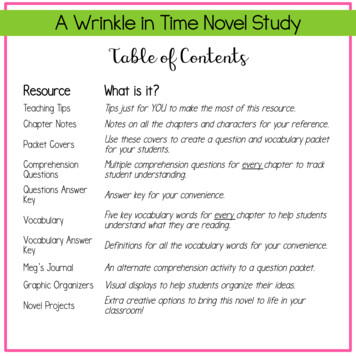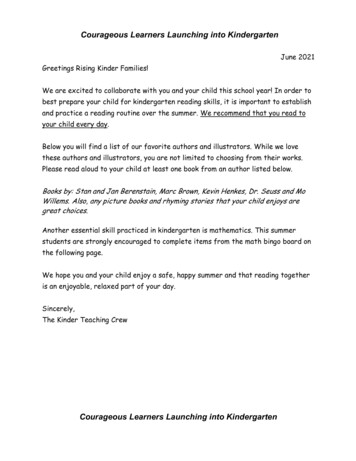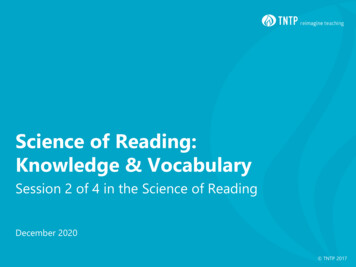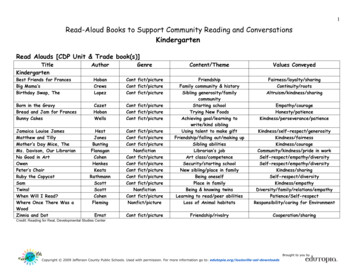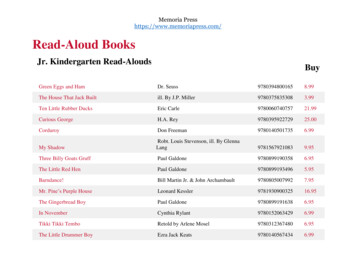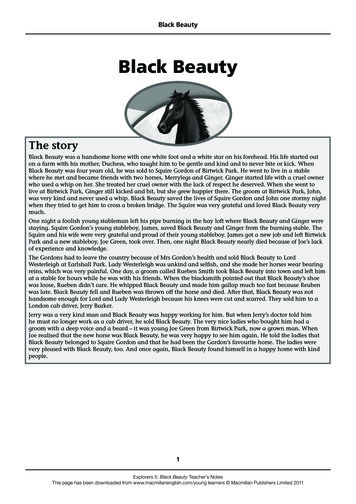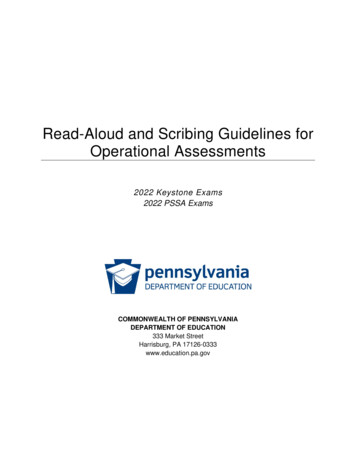
Transcription
Read-Aloud and Scribing Guidelines forOperational Assessments2022 Keystone Exams2022 PSSA ExamsCOMMONWEALTH OF PENNSYLVANIADEPARTMENT OF EDUCATION333 Market StreetHarrisburg, PA 17126-0333www.education.pa.gov
Commonwealth of PennsylvaniaTom Wolf, GovernorDepartment of EducationNoe Ortega, SecretaryOffice of Elementary and Secondary EducationSherri Smith, Acting Deputy SecretaryBureau of Curriculum, Assessment, and InstructionBrian W. Campbell, DirectorDivision of Assessment and AccountabilityBrian Truesdale, ChiefThe Pennsylvania Department of Education (PDE) does not discriminate in its educational programs,activities, or employment practices, based on race, color, national origin, [sex] gender, sexual orientation,disability, age, religion, ancestry, union membership, gender identity or expression, AIDS or HIV status, orany other legally protected category. Announcement of this policy is in accordance with State Lawincluding the Pennsylvania Human Relations Act and with Federal law, including Title VI and Title VII ofthe Civil Rights Act of 1964, Title IX of the Education Amendments of 1972, Section 504 of theRehabilitation Act of 1973, the Age Discrimination in Employment Act of 1967, and the Americans withDisabilities Act of 1990.The following persons have been designated to handle inquiries regarding the Pennsylvania Departmentof Education’s nondiscrimination policies:For Inquiries Concerning Nondiscrimination in Employment:Pennsylvania Department of EducationEqual Employment Opportunity RepresentativeBureau of Human ResourcesVoice Telephone: (717) 783-5446For Inquiries Concerning Nondiscrimination in All Other Pennsylvania Department of EducationPrograms and Activities:Pennsylvania Department of EducationSchool Services Unit Director333 Market Street, 5th Floor, Harrisburg, PA 17126-0333Voice Telephone: (717) 783-3750, Fax: (717) 783-6802If you have any questions about this publication or for additional copies, contact:Pennsylvania Department of EducationBureau of Curriculum, Assessment, and Instruction333 Market Street, 5th Floor, Harrisburg, PA 17126-0333Voice: (717) 705-6359, Fax: (717) 234-4071www.education.pa.govAll Media Requests/Inquiries: Contact the Office of Press & Communications at (717) 783-9802
Table of ContentsIntroduction . 1Test Feature vs. Accommodation . 2General Read-Aloud Guidelines . 3Answer Choices . 3Emphasis in Test Items . 3Fill in the Blank . 3PSSA English Language Arts Read-Aloud Guidelines . 4Sections 1 and 3: Conventions of Standard English (Writing) Multiple-Choice Questions . 4Stimulus Sentences . 4Guidelines for Punctuation Items . 5Guidelines for Capitalization Items . 5Guidelines for Spelling Items . 6Grade 3, Sections 1-3: Reading . 6Grades 4–8, Sections 1-3: Reading and Text Dependent Analysis . 6Keystone Literature Read-Aloud Guidelines . 7PSSA Mathematics/Keystone Algebra I Read-Aloud Guidelines . 7Symbols . 7Numbers. 7Graphs/Tables/Charts . 8Graphics/Diagrams/Figures/Clocks . 9PSSA Science/Keystone Biology Read-Aloud Guidelines . 10Chemical Symbols . 10Scientific Units . 10Graphs/Tables/Keys . 10Science Scenarios . 11Diagrams/Figures/Flowcharts . 11General Scribing Guidelines . 13PSSA English Language Arts Scribing Guidelines . 15
Multiple-choice (grades 3-8), Evidence-based Selected-responses (grades 3-8), and Short-answerQuestions (grade 3) . 15Text-Dependent Analysis Prompts (grades 4-8) . 15Keystone Literature Scribing Guidelines . 17PSSA Mathematics/Keystone Algebra I Scribing Guidelines . 17PSSA Science/Keystone Biology Scribing Guidelines . 17References . 18
IntroductionThe focus of the Read Aloud and Scribing Guidelines is to provide guidelines for “Readers” whoread words, phrases, or test items aloud and for “Scribes” who record student responses foroperational assessments in Pennsylvania for the Keystone Exams and the PennsylvaniaSystem of School Assessment (PSSA). The purpose of these guidelines is to ensureconsistency in the read-aloud and scribing events for students in classrooms throughout theCommonwealth of Pennsylvania to maintain fairness for all students.Changes to the Read Aloud and Scribing Guidelines for the 2021-2022 school year are notedusing red font in this manual.Revised 10/20211
Test Feature vs. AccommodationA “read aloud” may be considered to be a test feature or an accommodation. As a test feature,the read aloud of a word, phrase, or test item is allowable for all students. For more informationregarding the difference between a test feature and an accommodation, see the 2022Accommodations Guidelines. The current version of this document can be found at:www.education.pa.gov.For all content areas and subjects, Readers may not clarify, elaborate, paraphrase, assist, orcue a student through uneven voice inflection. Read the 2022 Accommodations Guidelines forspecific instructions regarding the guidelines for reading aloud to a student or a group ofstudents. Read aloud of any allowable test item should only occur at individual student requestunless otherwise specified as a documented accommodation for a non-English speaker or astudent with a disability.Scribing involves a scribe writing a response as a student dictates the response. This occursduring the administration of the assessment as students dictate the response orally or bygesturing or pointing to correct responses. This differs from transcribing, which occurs after theassessment is administered. Transcribing occurs when a student uses a device such as a wordprocessor, a speech-to-text device, or a recording device and the test administrator thentransfers those responses to the student’s answer booklet. If a student uses a Braille or largeprint form, scribing can be used, if the student responds orally. Transcribing can be used if thestudent responds using a Braille writer or Braille notetaker.The online test engine is compatible with a refreshable Braille device that works with JobAccess with Speech (JAWS). This feature eliminates the need for scribing or transcribing forthose students using a refreshable Braille device with the online test format.Scribing is considered an accommodation and is available for students who already use scribingon a day-to-day basis for instruction and assessment. This accommodation is available for astudent whose IEP team, Section 504 Services Plan team, or educational team determines thatscribing (dictation) is essential for the student to be able to access the test OR for a student whohas a current disabling injury. Scribing is allowable for all item types for PSSA Mathematics andScience and Keystone Algebra I, Biology, and Literature. Additionally, scribing is allowable forPSSA English Language Arts (ELA) for multiple-choice questions, evidence-based selectedresponse questions, and short-answer questions (Grade 3 only). Scribing is only allowable asan approved accommodation for ELA text-dependent analysis prompts (Grades 4‒8) with thesubmission of the 2022 PSSA TDA Scribing Accommodation form.Qualified teachers, counselors, administrators, and paraprofessionals employed by the LEAmay act as scribes. Any person who functions as a scribe for the PSSA or Keystone Examsmust complete the PSSA and Keystone Exams Test Administration online training module foundat: https://www.pstattraining.net/Additionally, any person functioning as a scribe for the PSSA or Keystone Exams must followthe procedures for scribing as described in this manual.Revised 10/20212
General Read-Aloud GuidelinesOf utmost importance when reading aloud any item or portion thereof is that the validity of theitem be maintained. Any portion of an item that might cue the correct answer or provideinappropriate assistance for the test taker must not be read aloud.Answer Choices For multiple-choice questions, read the answer choice letter, pause briefly, then readthe answer choice. Pause again before reading the next answer choice letter.Do not say anything prior to the answer choice letter, such as “answer choice” or“option.Emphasis in Test Items Emphasize words that are underlined or bolded as a part of the question being asked(e.g., not, best, or most) using voice inflection.Emphasize titles that are underlined, in quotation marks, or in italics by briefly pausingbefore and after the emphasis.Do not emphasize individual words or phrases that are underlined as part of a stimulusor answer choice.Fill in the Blank Read the blank element as “blank” preceded and followed by a pause. For example, “Iwould like to have either an apple (pause) blank (pause) a banana to eat with my lunch.”If the space to be filled in has a number, read it as “blank number x” where x is thenumber on the line.Revised 10/20213
PSSA English Language Arts Read-Aloud GuidelinesSections 1 and 3: Conventions of Standard English (Writing) MultipleChoice QuestionsA read-aloud in English is permitted for all Conventions of Standard English multiple-choicequestions found in sections 1 and 3 of the English Language Arts assessment at Grades 3–8 asper restrictions specified in the 2022 Accommodations Guidelines.A read-aloud in native language for the Text Dependent Analysis (TDA) prompts in Grades 4-8sections 2 and 3 of the ELA test is permitted for ELs enrolled in U.S. schools for fewer than 3years.Stimulus SentencesIn some cases, sentences within a larger stimulus will be sequentially numbered for ease ofreference for the students. When reading these paragraphs or groups of sentences, do not reador refer to the sentence numbersExample:Read the paragraph.(1) The Commonwealth of Pennsylvania encourages citizens to plant rain gardens. (2)Rain gardens capture storm water so that the water does not flow into storm drains. (3)Existing low spots or shallow pits lined with gravel make ideal locations for rain gardens.(4) If you use native plants in your rain garden, it will be easy to take care of and mighteven have attracted birds and butterflies. Which sentence in the paragraph has an error?A. sentence 1B. sentence 2C. sentence 3D. sentence 4The question above should be read aloud as follows:“Read the paragraph. (pause) The Commonwealth of Pennsylvania encourages citizens to plantrain gardens. Rain gardens capture storm water so that the water does not flow into stormdrains. Existing low spots or shallow pits lined with gravel make ideal locations for rain gardens.If you use native plants in your rain garden, it will be easy to take care of and might even haveattracted birds and butterflies. (pause) Which sentence in the paragraph has an error? (pause) A(pause) sentence 1, (pause) B (pause) sentence 2, (pause) C (pause) sentence 3, (pause) D(pause) sentence 4.”Revised 10/20214
Guidelines for Punctuation Items Do not say the name of any punctuation used in test questions.For end punctuation, read the sentence with normal inflection.Do not add unnatural inflections that may cue a student.Do not indicate quotation marks or apostrophes in any manner.For commas, briefly pause wherever a comma appears in a sentence.ExampleThe question above should be read aloud as follows:“Which sentence is punctuated correctly? (pause) A. (pause) He said my new kitten loves to rollin the grass. (pause) B. (pause) He said my new kitten loves to roll in the grass. (pause) C.(pause) He said (pause) my new kitten loves to roll in the grass. (pause) D. (pause) He said(pause) my new kitten loves to roll in the grass.”Guidelines for Capitalization Items Do not provide a verbal indication of capitalization within items.The question above should be read aloud as follows:“Which sentence has a mistake in capitalization? (pause) A. (pause) We enjoyed reading theplay (pause) if you give a mouse a cookie. (pause) B. (pause) Our class loudly sang the song(pause) it’s a small world (pause) at the show. (pause) C. (pause) My favorite chapter in thebook is called (pause) first day of spring. (pause) D. (pause) I read the book (pause) two littletrains (pause) three times already today.”Revised 10/20215
Guidelines for Spelling Items Speak the word rather than the individual letters in the word.Pronounce misspelled words as though they were spelled correctly.ExampleThe question above should be read aloud as follows:“Read the sentence. (pause) Several students were sitting under the tree. (pause) Which wordin the sentence is not spelled correctly? (pause) A. (pause) students, (pause) B (pause) were,(pause) C (pause) sitting, (pause), D (pause) under.”Grade 3, Sections 1-3: ReadingA read aloud is not permitted for any passage, associated multiple-choice question (or answerchoice), evidence-based selected response question (or answer choice), or short-answerquestion found in Sections 1-3 of the PSSA English Language Arts assessment for Grade 3.Grades 4–8, Sections 1-3: Reading and Text Dependent AnalysisA read aloud is not permitted for any passage, associated multiple-choice question (or answerchoice), or evidence-based selected response question (or answer choice) found in Sections 13 of the PSSA English Language Arts assessment for Grades 4–8.It is permissible to read aloud the text-dependent analysis prompt (or a word or phrase foundfrom the text-dependent analysis prompt) found at the end of Section 2 and Section 3 of thePSSA English Language Arts assessment for Grades 4–8 on an individual basis at studentrequest.Revised 10/20216
Keystone Literature Read-Aloud GuidelinesA read aloud is not permitted for any passage, multiple-choice question (or answer choice), orconstructed-response question for a Keystone Literature Exam.PSSA Mathematics/Keystone Algebra I Read-Aloud GuidelinesA read aloud is permitted for both the PSSA Mathematics Tests and the Keystone Algebra IExams for all multiple-choice questions (and answer choices) and open-ended/constructedresponse questions. Students with a documented accommodation for a disability or for a nonEnglish-speaking designation may have the entire assessment read aloud in an appropriatesetting; otherwise, they may request a word, phrase, or test item be read aloud on an individualbasis. A read-aloud in native language is permitted for PSSA Mathematics Tests and theKeystone Algebra I Exams for ELs enrolled in U.S. schools for fewer than 3 years.SymbolsSymbols should be read in a way that does not cue the correct answer or provide inappropriateassistance for the test taker.The following symbols are each read as “times”For a number or variable followed by a grouping symbol, read the number/variable followed by“times the quantity” (e.g., 3(x 7) would be read as “3 times the quantity x plus 7”).The symbolswould be read as “segment A B,” “line A B,” or “ray A B.” Pausebetween speaking the letters.Each of the following symbols would be read as “a symbol”:Exponents should be read as “x to the n” for xn.NumbersNumbers should be read in a way that does not cue the correct answer or provide inappropriateassistance for the test taker. If the question is assessing a student’s knowledge of place value,read the number using the following examples: 2,224—read as “two, comma, two, two, four”10.205—read as “one, zero, point, two, zero, five”In questions where the student is given a written-out dollar value to match with a numericalvalue, 18.24 would be read as “dollar sign, one, eight, point, two, four.” In all other instances, 18.24 would be read as “eighteen dollars and twenty-four cents.”Revised 10/20217
For questions where the place value is not relevant, read the numbers in standard form (e.g.,1,234 would be read as one thousand, two hundred thirty-four).Fractions should be read as “the fraction (numerator) over (denominator)” (e.g., ¾ would beread as “the fraction three over four).Mixed numbers should be read as “(whole number) and the fraction (numerator) over(denominator)” (e.g., 2 ¼ would be read as “two and the fraction one over four”). Negativenumbers are scripted as “negative (number).”Graphs/Tables/ChartsFirst read the title. “The title of the [type of graph or table] is [title].”Number lines: “The title of the number line is [title]. The label below the number line is [label.]The numbers below the number line are [numbers]. The letters above the number line are[letters].”Line plots: “The title of the line plot is [title]. The label below the line plot is [label]. The numbersbelow the line plot are [numbers].”Tally charts: Read the title and headings. Refer to the tally marks as “some tally marks” ratherthan the number of tally marks shown. For one tally mark, read “a tally mark” and for zero tallymarks, read “no tally marks.”Stem-and-leaf plots: “The title of the stem-and-leaf plot is [title]. The numbers on the stem-andleaf plot are [read each row from left to right]. Below the stem-and-leaf plot is a key. Key,[number] bar [number] equals [number].”Double stem-and-leaf plots: “The title of the double stem-and-leaf plot is [title]. The numbers onthe double stem-and-leaf plot are [read each row from left to right]. Below the double stem-andleaf plot is a key. Key, [number] bar [number] equals [number]; [number] bar [number] equals[number].”Box-and-whisker plots: “The title of the box-and-whisker plot is [title]. The label below the boxand-whisker plot is [label]. The numbers below the box-and-whisker plot are [numbers from leftto right].”Bar graphs: “The title of the bar graph is [title]. The label to the left of the bar graph is [label].The numbers to the left of the bar graph are [numbers]. The label below the bar graph is [label].The words below the bars are [bar labels].”Double bar graphs: “The title of the bar graph is [title]. The label to the left of the bar graph is[label]. The numbers to the left of the bar graph are [numbers]. The label below the graph is[label]. The words below the bars are [bar labels]. Below the bar graph is a key. Key, [label],[label].”Revised 10/20218
Circle graphs: “The title of the circle graph is [title]. The labels on the circle graph are [read thelabels starting at the 9-o’clock position and going around clockwise].”First quadrant graphs: “The title of the graph is [title]. The label to the left of the graph is [label].The numbers to the left of the graph are [numbers]. The label below the graph is [label]. Thenumbers below the graph are [numbers].”Coordinate grids: “The title of the (coordinate) (grid/plane)1 is [title].2 The numbers to the left ofthe vertical line are [read numbers on y-axis from bottom to top]. The numbers below thehorizontal line are [read numbers on x-axis from left to right]. The points marked on the grid arelabeled [points].31. Use coordinate grid or coordinate plane based on what is referenced in the firstpartof the question.2. If there is no title, replace the first sentence with “A coordinate grid is shown.”3. Only read the point labels if they are words.Graphics/Diagrams/Figures/ClocksThe read aloud of most graphics follows this pattern: “The title of the picture (or figure ordiagram) is [title].” (Use picture, figure, or diagram based on what is referenced in the first partof the question. Other parts of the picture are only included if measurements or other pertinentinformation is included.)An analog clock is referred to as a clock; a digital clock is referred to as a digital clock. If there isno title, then read “A (digital) clock is shown,” followed by any labels.Revised 10/20219
PSSA Science/Keystone Biology Read-Aloud GuidelinesA read aloud is permitted for both the PSSA Science Tests and the Keystone Biology Exam forall multiple-choice questions (and answer choices), open-ended/constructed-responsequestions, and scenarios. Students may have the entire assessment read aloud or they mayrequest a word, phrase, or test item be read aloud. A read-aloud in native language is permittedfor the PSSA Science Tests and the Keystone Biology Exam for ELs enrolled in U.S. schools forfewer than 3 years.Chemical SymbolsSymbols should be read in a way that does not cue the correct answer or provide a hint for thetest taker. If a question includes both the name and the symbol of an element or formula of acompound, the symbol/formula may be read as the name in later instances within the testquestion. If only the symbol/formula appears within a test question, only the symbol/formulashould be read (e.g., Cl2 should be read as “C, l, two,” not as “chlorine gas” or “chlorine”).Scientific UnitsAbbreviated units should be described using the full word(s). For example, 3 m should be readas “three meters,” and 9.8 m/s2 should be read as “nine point eight meters per secondsquared.”Graphs/Tables/KeysFor graphs, first read the title of the graph. Then read the label and the numbers on each axis,referring to the horizontal axis as the bottom of the graph and the vertical axis as the left side ofthe graph. The order will depend upon the content of the graph. Describe the key if there is one.For data tables, first read the title of the data table. If the data table has two columns, read asfollows: The heading of the left column is “ ”The heading of the right column is “ ”The data from left to right are as follows:Row one:Row two:Etc.Revised 10/202110
If the data table has three or more columns, read as follows: The headings of the columns from left to right are: “ ”The data from left to right are as follows:Row one:Row two:Etc.Headings with units should be read with an insertion of “in” between the measurement and theunit (e.g., “Distance (feet)” should be read as “Distance in feet”).Most data tables should be read left to right by each row; however, it is more appropriate to readsome data vertically for each column.Science ScenariosFirst read the directions above the scenario, and then read the phrase “The title of the scenariois ‘’.”If a picture/diagram/data table shown within the scenario is not referenced in the sentence priorto its appearance, use the phrase “A (picture/diagram/data table) is shown. The title of the(picture/diagram/data table) is ‘’.”Diagrams/Figures/FlowchartsAlways read the title if there is one. “The title of the (diagram, figure, flowchart, food web, etc.) is(‘’).”Diagrams with labels should be described in a concise format including all text/labels, as in thefollowing example:“The drawing shows a side view of a grasshopper. There are four labels from left to right:compound eye, hard outer covering, double wings, jointed hind legs.”Revised 10/202111
Food webs should be described by starting at the bottom of the food web and reading all labelsand describing the direction of arrows.Flowcharts: Horizontal flowcharts should be read left to right and include a description of the labelsand arrow directions.Vertical flowcharts should be read in the direction indicated by the arrows and include adescription of the labels. If arrows are not present, they should be read top to bottomand include a description of the labels.Note: A graphic should be referenced by the Reader the same way it is identified in theintroduction of the item (or scenario), with the same term used consistently throughout thescript. Picture, diagram, and drawing are not interchangeable.Revised 10/202112
General Scribing GuidelinesScribing is an allowable accommodation for a student who has a physical disability that severelylimits or prevents the student’s motor process of writing, typing, or recording responses duringtesting (including pain and/or fracture) or for a student who has a documented disability in thearea of written expression which results in significant interference in the student’s ability toexpress knowledge in writing/keyboarding, even after varied and repeated attempts to teach thestudent to do so.Interpreters may translate students’ non-English oral responses into written English for theMathematics, Algebra I, Science, and Biology assessments for ELs enrolled in U.S. schools forfewer than 3 years. Interpreters must not change the meaning of the response or make anycorrections in the response.Interpreters may not translate student responses to open-ended items on the ELA PSSA orKeystone Literature Exam from a non-English language into English. Interpreters may nottranslate student responses to the text-dependent analysis prompts of the ELA PSSA test froma non-English language response into English.Scribing must be used only by a student who already uses scribing on a day-to-day basis forinstruction and assessment and whose IEP team, Section 504 Services Plan team, oreducational team determines that scribing is essential for the student to access the test. IEPand 504 Services Plan teams should consider the following before listing the accommodation inthe student’s IEP/504 plan or MTSS documentation: Is the student’s inability to express in writing documented in evaluation summaries fromlocally administered diagnostic assessments?Does the student receive appropriate ongoing, intensive instruction and/or interventionsto learn written expression?Before using a human scribe (dictation) the LEA/school team must consider one of thefollowing:Mixed-Mode Version The student can independently respond to selected-response questions bypressing A, B, C, or D on a keyboard.The student cannot type an extended response on a keyboard.The student can handwrite the constructed response in the booklet.The student should use the Mixed-Mode accommodation to write eachconstructed response in the provided answer booklet.No scribing or transcribing is required for this option.Refer to the 2022 Accommodations Guidelines for details regarding the MixedMode response.Revised 10/202113
Paper Version The student cannot independently bubble the answer sheet. The student may point to, state, or mark the answer choice in the paper testbooklet. Test administrator/scribe marks the answer sheet.OR The student can type extended response on a keyboard. Test administrator/scribetranscribes on the answer sheet.Online Version The student can independently respond to selected-response questions bypressing A, B, C, or D on a keyboard. PDE recommends that the studentparticipate in the online version to allow the student as much independence aspossible. The test administrator/scribe types the student’s dictated responses directly intoonline test.The following guidelines must be followed whenever scribing
Read the blank element as "blank" preceded and followed by a pause. For example, "I would like to have either an apple (pause) blank (pause) a banana to eat with my lunch." If the space to be filled in has a number, read it as "blank number x" where x is the number on the line.

